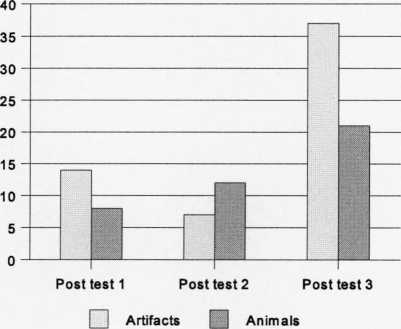The differences were found to be significant for post test 2 (Wilcoxon: Z=2.1, p<.05) and
post test 3 (Wilcoxon: Z=2.4, p<.05). The same pattern was also found for each one of the
groups. The differences were significant for the Ostensive definition group during post test
3 (Wilcoxon: Z= 2.2, p<.05).
Is the provision of thematic justifications influenced by the semantic domain of the lexical
items ?
Figure 7.27 below shows that during post tests 1 and 3 the children provided more “thematic”
justifications for words describing artifacts than for those describing animals. The differences
were found to be significant for post test 3 (Wilcoxon: Z=2.2, p<.05). The same pattern was
found for each group, however the differences were not significant.
Figure 7.27 Provision of thematic justifications by semantic domain across testing

Key findings from the Association task
Is there a differential impact of the type of exposure to new lexical items that the children
receive on the provision of appropriate justifications?
• Children’s provision of justifications differed significantly by group during post test
3. Particularly, all the experimental groups provided significantly more justifications
than the Control group. In addition, the Definition group provided more justifications
than the Phonological control and the Ostensive definition groups.
247
More intriguing information
1. Flatliners: Ideology and Rational Learning in the Diffusion of the Flat Tax2. Visual Perception of Humanoid Movement
3. A dynamic approach to the tendency of industries to cluster
4. EXECUTIVE SUMMARIES
5. Macro-regional evaluation of the Structural Funds using the HERMIN modelling framework
6. Social Cohesion as a Real-life Phenomenon: Exploring the Validity of the Universalist and Particularist Perspectives
7. The name is absent
8. The name is absent
9. Regional Intergration and Migration: An Economic Geography Model with Hetergenous Labour Force
10. The name is absent